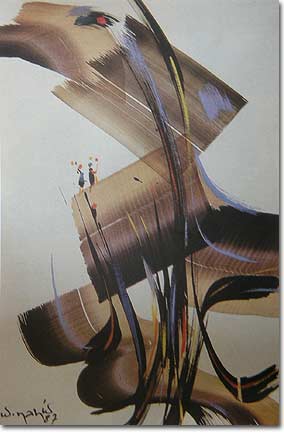The Movement and Color by André Parinaud
Président de l'académie Nationale des Arts de la Rue.
Président du grand prix de l'affiche française.
Président du Salon de l'affiche et des arts de la rue. Paris.
In our time, where the civilizations are face to face, not only to challenge, but also to get to know each other and, if possible, to marry. The work of Wajih Nahle is a bridge between the Moslem world and the occident. It is not certain that the three giants who lead the world, strapped in their materialistic ambitions dyed with artificial sauce of false philosophies adapted to the imperialisms, determine the meaning of history. As if the cataclysm is not at the end of their rivalries, it is unnecessary that the planet, one day tries to live. And then the Spirit and its styles will take the upper side. Greece defeated, imposed on Rome more than a victory could have done. I think that getting prepared today are the true formulas of tomorrows' quality of life; that the little Europe, clumsy and divided against herself, but attempting to make its unity, and that the Arab world, which petrol had placed since half a century in the center of happenings (who could appear, the one and the other for the "greats" as land of stake) are preparing in reality a shining revenge in forging the arms of the soul. I think that their artists, their thinkers, their scientists, those who are not contaminated by shortsighted politics and commerces, are actually elaborating the line of strength of the future. Their works are the crucibles new and true values. It is on this level that the gesture of Wajih Nahle is situated.
He belongs to this marvelous little country, the Lebanon, balcony of the Orient on the Mediterranean Europe, Gordion knot of the values of the past and the present, magician's pot where the forces of most illustrious races of the planet pulsate. He is linked organically to this earth of all contrasts and dreams. His other native virtue is that he breathes God with the natural of the desert hermits. His paintings' gesture could be mystical but justly, the presence of the occident, its culture, its intelligence, its plastic provocation give to his word a universal range.
Arab, Moselm, most certainly, but with all the rational acuteness of the Occidental are the evidence is in his writing. His purpose could have considered of putting on page the name of Allah, of saying with talent the graphical beauty of sign of the Arab calligraphy. He would have become the image maker of a people and one of the first painters’s of his country, a marvelous enlightener of God's alphabet, taking like the plastic following of the Great Priests. His historical dimension is having understood that his true inspiration was at the level of his time as much as of his country.
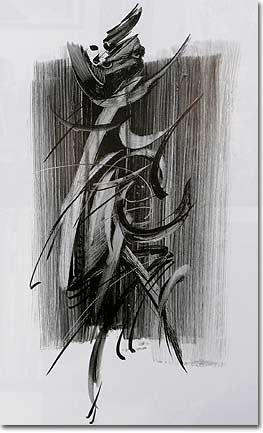
Wajih Nahle refused the easiness which would have consisted to exploit the harmonious values of the letter, and which would have ended by the flourish, it means to the exaltation of person, of the individualism, and he prefers to choose the efficacy, which is the communication, the truth sensible to all. It is essential that each of Nahle's paintings, not only expresses the perfect harmony, the flasing gesture, the identity of its author, but also wants to say something. He paints names, shouts, wishes: his painting is prayer, faith, will. He wants himself depth and form. He is the making and the speaking; each of his works is a scenery of God. So, he is the most figural of the abstracts and the most abstract of the figurative.
I believe that the occidental painting is at a turning which will achieve the crisis, begun with Du champ. In a three quarter of a century, the artists had broken the old pictures and the sclerotic structures of the spirit, which were paralyzing the intelligence and the sensibility. The old shaky heritage is liquidated. The essence of things still exists and is looking for a new cover. The great abstract adventure, in putting into evidence the quality and independence of forms and colors, had revealed the language of the new values. The konetic, the hop and pop established little by little the code of the relation between the visual and the concept. A new reality appeared. One could even say that everything concurs to prepare new forms of expression: the technique of the message transmission, for example, by the publicity; the suggestion of cinema pictures; the vision evolution at the planetary scale through television, another organical conception of the perception of felt speed, at the car level; another sensation of space registered with the aviation. Man changes skin and a big mutation is at the door of history.
Wajin Nahle is one of those by which the meant could become meaning and model. As the generosity of his gesture is not less big than that of an occidental artist, and the command which he accepts in choosing the word that he is going to paint does not diminish the plastically range of his creation. It is a supplementary challenge he imposes.
Each of his paintings has the full meaning of the word, and his message in becoming fully plastically, takes a spiritual aureole which is the true measure of the art of painting.
If the modern occident finds one day his classicism, it will not be but by the popular adhesion, by the establishment of a real communication, by the apparition of an evidence. Nahle shows the road.
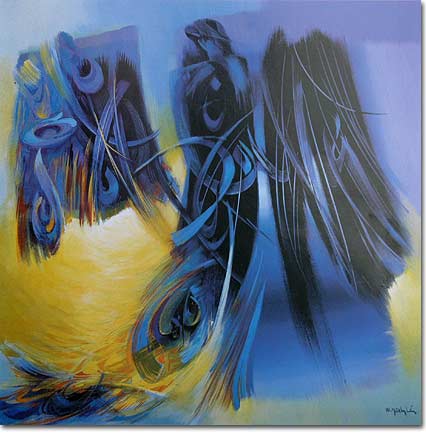
By him, the Arab scripture becomes transcendence. His painting makes explode the word in order to give to it its magnetism and let it rediscover its fascination. He wants himself as painter of the great adventures of the modern art permitted to him to find its solution. One can see how he composed his palette, established his papers, and enlarged his gesture, with the contact of the great works of the modern world. Today, rediscovering the strength of the great arabesque which inspired the masters of the Moslem art, he reaches us with the force of the instinct and the quality of two cultures, assimilated perfectly.
Even when one ignores the signification of the words Nahle paints, one feels the affirmation because his faith is true and his art is imprint with a strong poetry. I could say that Nahle is one of the pioneers of this school of message which may become the great élan of the classicism to be born.
He half-opened the doors of the human truth of today's painting. The collective world, which is slowly attempting to define its future rules demands an art where it could recognize it self in. The time of the furious individualism has used up his magic. The little games of society and the trickeries of the self have lost all charm. An immense hunger will develop: The appetite of a planetary race looking for the pictures of its strength and it is the message one must communicate.
A Plethora of Signs by Adonis, a poet
Once you look at Wajih Nahle's paintings, you feel as if he uses the body of words to take you to the beginnings. Then, he tears this body apart and leaves its parts scattered and goes on to mix them together, make them contrast against each other or keeps them together, hence the lines are skillfully dispersed.
When the words turn into lines, they enter the place and space to turn into lively movement that bends, wavers, takes sharp edges, gets intermingled, interacts, goes in parallel directions, turn, groups and smoothly flows to offer implications that are loaded with signs.
Indeed, it is neither the line nor the figure that have an implication of their own, but they conceal a meaning or show an extent or extend the road to the unknown.
A line is a symbol of another writing to the world. It is another shape that can have an endless shape. In this context, the abstract and the tangible are entwined. The imagination and concrete material can get together.
The real world gives an indication of this embrace. A living person can be a sign in itself. Everything in this space that we sometimes call inside and sometime outside is nothing more than a sign. There is no tangible nature and the mind is not active. Only the memory and imagination are present and alive. They are always in a state of constant vigilance.
When we view and read the paintings of Wajih Nahle, it seems as if other senses are born to enable us to integrate with the world around us and to turn our life into a plethora of lines and signs.
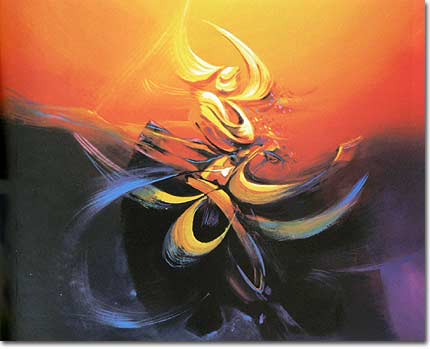
A Dictionary with a New Alphabet by Henry Zughaib, a Poet
He seems as if he paints with light. His brush seems in his fingers like a lighthouse that carries colors in a magic of creation. His rich imagination has a broad horizon that is conveyed to the white canvas that can hardly cope with the space. It breaks the finite horizon into a light that has an unlimited extend and is not besieged by any frame.
Where does his painting start and where does it end?
This is his artistic alphabet that no one as yet has decoded its secrets. It is quite likely that anyone can try to look at the mystery that remains and cannot be decoded expect by him.
From the day of relinquishing the impressionism (Which in spite of its difficulty has been skillfully handled by his brush that is capable of dealing with the most difficult expression) to embrace the alphabetic artistic style, the letters have ceased to be a set of flat drawings but very deep lines going to the roots to be able to grow into words. It is a medium of expression. The letters dance to the tunes of the spirit to produce colors of joy and delight. A painting is no longer made of static letters but has become a bride made up of lively and dynamic letters that exhausted the frame but the painting remains lively without feeling tried.
From the artistic alphabet to the dervishes, there are sighs of beauty moving on the white canvass to turn the canvass into a song made of a melody of color through which run the lines that remain bright, because the color is faster than a line and a line is faster than a letter. Here the letter is no longer part of a word but has become, at times, the whole word.
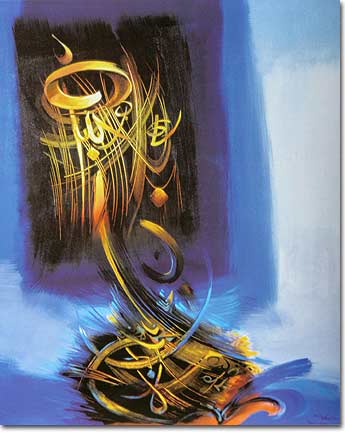
It penetrates the inner self more and more to inspire more beauty and to produce shapes that are not heartless geometrical designs or decorative plans. They are shapes that transcend the geometrical measurements to other kinds of measurement creating ideas and inspiring impressions. In brief, they are all combined to make a painting into an endless festival of geometrical designs.
He even goes further to paint with light.
It is him who paints with light. For him, a brush is not capable of expression and the colors are no able to scream. The white canvass cannot offer him the extent of expression. It is not unusual that he has broken every familiar rule and decided to boldly paint with light.
His medium is light that cannot be touched. His method is light that cannot be put together. It is light that comes from everywhere and goes everywhere.
How can he limit the light? How can he touch the rays and break them to yield under the force of his brush cleverly producing the tempo of his melodious art?
That is his genius. That is his unique skill. That is his great secret, painting with light.
Who can dare to make light the material for his brush? It is he who could dare.
It is not unusual that he could provide our artistic life with a colors full melody of beauty. A melody signed by notes of transparent flirtation, translucent inspiration and sensitive talent that is felt in every painting that is the pride of Lebanon in the world's art galleries. In brief, his works are more than the product of a brush, colors and white canvass. They are the paintings of light, an expression of the unity of light in a new artistic alphabet.
It is an alphabet pioneered by Wajih Nahle.
